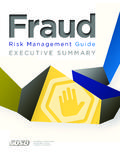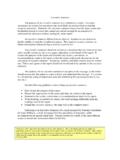Transcription of Executive Summary EXECUTIVE SUMMARY - FATF …
1 Anti-money laundering and counter-terrorist financing measures in the United States 2016 FATF and APG 2016 3 EXECUTIVE SUMMARY EXECUTIVE SUMMARY 1. This report provides a SUMMARY of the anti-money laundering and combating the financing of terrorism (AML/CFT) measures in place in the United States at the date of the on-site visit (18 January 2016 to 5 February 2016). It analyses the level of compliance with the FATF 40 Recommendations, the level of effectiveness of its AML/CFT system, and makes recommendations on how the system could be strengthened.
2 A. Key Findings The AML/CFT framework in the is well developed and robust. Domestic coordination and cooperation on AML/CFT issues is sophisticated and has matured since the previous evaluation in 2006. The understanding of money laundering (ML) and terrorist financing (TF) risks is well-supported by a variety of ongoing and complementary risk assessment processes, including the 2015 National Money Laundering Risk Assessment (NMLRA) and National Terrorist Financing Risk Assessment (NTFRA), which were both published. The national AML/CFT strategies, key priorities and efforts of law enforcement and other agencies seem to be driven by these processes and are coordinated at the Federal level across a vast spectrum of agencies in a number of areas.
3 The financial sectors bear most of the burden in respect of required measures under the Bank Secrecy Act (BSA). Financial institutions (FIs), in general, have an evolved understanding of ML/TF risks and obligations, and have systems and processes for implementing preventive measures, including for on-boarding customers, transaction monitoring and reporting suspicious transactions. However, the regulatory framework has some significant gaps, including minimal coverage of certain institutions and businesses (investment advisers (IAs), lawyers, accountants, real estate agents, trust and company service providers (other than trust companies).)
4 Minimal measures are imposed on designated non-fi nancial businesses and professions (DNFBPs), other than casinos and dealers in precious metals and stones, and consist of the general obligation applying to all trades and businesses to report transactions (or a series of transactions) involving more than USD 10 000 in cash, and targeted financial sanctions (TFS) requirements. Other comprehensive AML/CFT obligations do not apply to these 4 Anti-money laundering and counter-terrorist financing measures in the United States 2016 FATF and APG 2016 EXECUTIVE SUMMARY sectors. In the context the vulnerability of these minimally covered DNFBP sectors is significant, considering the many examples identified by the national risk assessment process.
5 Law enforcement efforts rest on a well-established task force environment which enables the pooling of expertise from a wide range of law enforcement agencies (LEAs), including prosecutors, to support quality ML/TF investigation and prosecution outcomes. Overall, LEAs have access to a wide range of financial intelligence, capabilities and expertise allowing them to trace assets, identify targets and undertake expert financial ML/TF investigations. There is a strong focus on following the money in predicate offence investigations at the Federal level. A similar focus on identifying terrorist financiers in terrorism-related investigations applies.
6 The investigates and prosecutes TF networks aggressively in line with its risk profile. International cooperation in these areas is generally effective though improvements are underway to further improve the timely handling of (a large volume) of mutual legal assistance (MLA) and extradition requests. Lack of timely access to adequate, accurate and current beneficial ownership (BO) information remains one of the fundamental gaps in the context. The NMLRA identifies examples of legal persons being abused for ML, in particular, through the use of complex structures to hide ownership. While authorities did provide case examples of successful investigations in these areas, challenges in ensuring timely access to and availability of BO information more generally raises significant concerns, bearing in mind risk and context.
7 At the Federal level, the achieves over 1 200 ML convictions a year. Many of these cases are large, complex, white collar crime cases, in line with the country s risk profile. Federal authorities have the lead role in all large and/or international investigations. There is however no uniform approach to State-level AML efforts and it is not clear that all States give ML due priority. The AML system would benefit from ensuring that a range of tax crimes are predicate offenses for ML. The Federal authorities aggressively pursue high-value confiscation in large and complex cases, in respect of assets located both domestically and abroad.
8 The authorities effectively resort to criminal, civil and administrative tools to forfeit assets. At State and local levels, there is little available information, though it appears that civil forfeiture is vigorously pursued by some States. The authorities effectively implement targeted financial sanctions for both terrorism and proliferation financing purposes, though not all designations have resulted in domestic designations (mainly on the basis of insufficient identifiers). Most designations take place without delay, and are effectively communicated to the private sector. The Specially Designated Nationals and Blocked Persons List (SDN List) is used by thousands of FIs across the and beyond which gives the sanctions regime a global effect in line with the size, complexity and international reach of the financial system.
9 The has had significant success in identifying the funds/other assets of designated persons/entities, Anti-money laundering and counter-terrorist financing measures in the United States 2016 FATF and APG 2016 5 EXECUTIVE SUMMARY and preventing them from operating or executing financial transactions related to terrorism and proliferation. Only minor improvements are needed in this area. AML/CFT supervision of the banking and securities sectors appears to be robust as a whole, and is evolving for money services businesses (MSBs) through greater coordination at the State level. The has a range of sanctions that it can and does impose on FIs as well as an array of dissuasive remedial measures, including informal supervisory actions.
10 These measures seem to have the desired impact on achieving the supervisory objectives. The most significant supervisory gap is lack of comprehensive AML/CFT supervisory processes for the DNFBPs, other than casinos. B. Risks and General Situation 2. The global dominance of the dollar generates trillions of dollars of daily transaction volume through banks, which creates significant exposure to potential ML activity (generated out of both domestic and foreign predicate offenses) and risks of cross-border illicit flows. The also faces significant risks from TF and is vulnerable to such abuse because of the unique scope, openness and reach of its financial system globally, and the direct threat posed by terrorist groups to interests.















